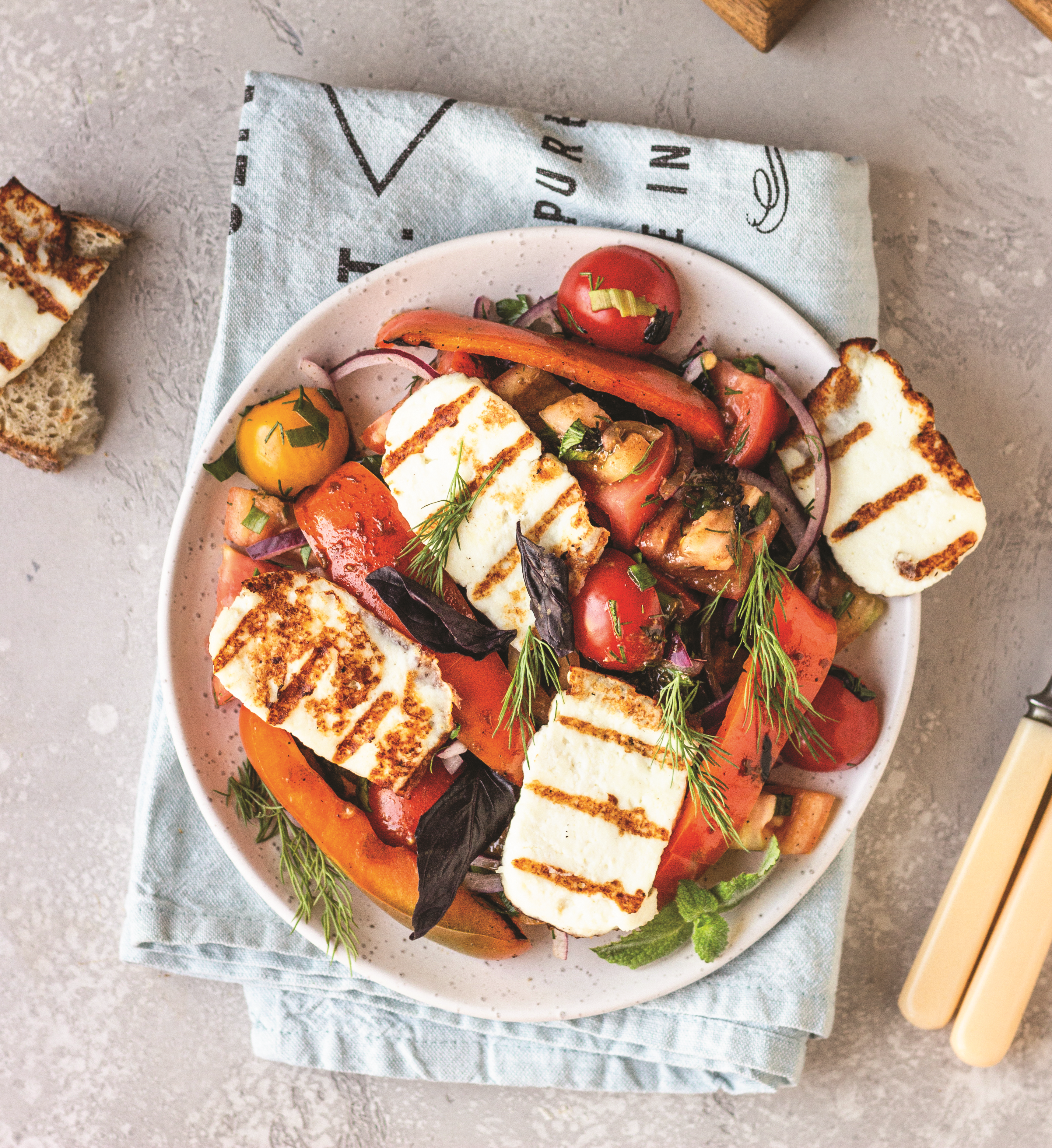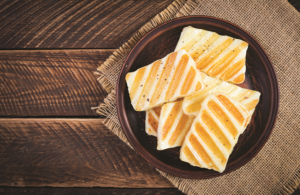
The fact that one of the UK’s favorite cheeses is a salty, pale, semi-hard item from a tiny island 2,000 miles away should probably raise more eyebrows than it does.
Halloumi, though synonymous with Cyprus, is—depending on which survey you consult— about as popular in the British Isles as its own darling cheddar, and even more so than Stilton. Due to its high melting point, Brits typically brown slices of it in a pan, and toss them in a salad in lieu of chicken, or on a burger with coleslaw. Sometimes, we like it floured and deep fried like French fries. This is probably an act of irreverence to Cypriots, who traditionally eat it fresh as a table cheese.
The UK is the largest importer of halloumi in the world, and many have offered their version as to why. Is it because, when British barbecue season rolls round, it’s well-suited to the grill? Perhaps it has something to do with the fact that a third of all holiday makers to Cyprus are Brits? Or is it more down to it being an inoffensive cheese and, like chefs’ favorite, burrata, it needs very little prep? Maybe we can just chalk it up to being Mediterranean, and by extension, “healthy.”
Such theories don’t quite go far enough to explain Brits’ obsession with halloumi. Especially since it’s traditionally made with sheep’s and goat’s milk, while cow’s milk versions of the cheese are what dominate British supermarket shelves.
Let’s go back to 1878, when the Ottomans ceded Cyprus to the British Empire. The British (but, ultimately, not the Cypriots) were happy to have it fall into their possession—Cyprus was later described by British officials as a “fortress colony” and a “potential centre of operations against the rising tide of Egyptian and Arab nationalism.” Perceived as an “unsinkable aircraft carrier,” the island was, and still is, only really prized by Britain for its strategic value.
Cyprus remained under British colonial control for the next 80 years, until 1960. To this day, its post boxes, embossed with Queen Elizabeth II’s royal cypher, and red telephone cubicles (most of which are now painted green) remain. Cypriots drive on the left side of the road (Malta being the only other European country to adopt this from the UK); put on breakfast fry-ups and serve Sunday roasts; and shop in local branches of the British department stores Debenhams and Marks & Spencer.
Some of the most significant residues of British occupation aren’t quite so out in the open. In 1912, the British authorities in Cyprus started importing Devon cattle, a breed native to Southwest England. The herd grew and, due to the higher quantity of milk that cows produce over sheep or goats, cow dairying took hold. While as late as the 1970s cow’s milk was not readily available to Cypriots living in rural areas, city dwellers were quick to embrace it. “Within the last few years,” wrote Cyprus’ Director of Agriculture, William Bevan, in 1919, “the more well-to-do townspeople have taken to drinking cow’s milk, when obtainable.”
Bevan also noted, “If more attention were paid to growing fodder crops, cattle breeding could be greatly increased.” Capitalist ideals began to foster in Cyprus under the British administration. Where before occupation it was seen as a mark of failure for a family to buy halloumi rather than produce their own, 1939 saw the founding of Pittas, a Cypriot cheese processor. Pittas would later control almost half the local halloumi market, 35 percent of exports, and eventually supply Sainsbury’s supermarket on Cromwell Road in London in the 1980s—the first time Cypriots in the UK could get their hands on halloumi from a mainstream source.
Pittas was the first producer to pasteurize its cheese so that it could be exported, and, recognizing the cheaper cost of goat’s milk over sheep’s, adjusted its halloumi recipes accordingly. Then, as cow’s milk was made more available, that was incorporated too. These days, some “halloumi” can contain up to 95 percent cow’s milk. Cypriots call it “Pittas cheese” or “chewing gum cheese” to avoid sullying the halloumi name.
Little surprise, then, that the art of halloumi-making is dying out. But, due to its fascinations, Britain has in recent years gained some of its own squeaky cheese producers. “The reason I started the business is to produce something that I remember and that I wanted to eat, and not be forced to eat the stuff that’s produced unethically and sold in the supermarket,” says Anthony Heard, founder of Kupros, a small dairy in North London. Made according to his grandmother’s recipe, the result is Anglum—a cheese more buttery and subtle than mainstream halloumi, but also familiar enough to demand the attention of halloumi-enamored Brits.
Heard’s grandparents settled in London in the 1950s, making him one of the now 300,000 people in the UK with a Cypriot background. Even so, following halloumi-making traditions word-for-word isn’t in his playbook. “I started the business on sheep’s milk, and that’s what got my products well known, but I don’t really care about the term ‘authenticity,’” he says. “If you can find a good cow’s milk that lives up to the sensibilities of the original, and you’re doing things all above board, then fantastic. I’m all for it as long as it’s good.”
Broadly speaking, not staying authentic to the original has caused widespread consternation. Imitators across the world using cow’s milk abound, and in the last few decades of halloumi’s growing popularity, conversations have grown around how and where the cheese should be made. In 2021 the European Union Commission granted halloumi PDO (Protected Designation of Origin) status, which means that only halloumi produced in Cyprus and “according to the traditional recipe” could be marketed in the EU as halloumi. Crucially, though, it must be made with at least 51 percent sheep’s or goat’s milk. A stipulation that, since industrial production heavily favors cow’s milk, has been lambasted by Cyprus’ commercial producers.
To further complicate matters, Britain—where 40 percent of all Cypriot halloumi is shipped—is no longer in the EU, and so does not recognize the EU’s regulations. Halloumi is still protected under UK trademark laws, meaning only halloumi produced in Cyprus can be labeled as such. “We use the halloumi method to make our cheese,” says Razan Alsous, who founded her creamery, Yorkshire Dama, after fleeing to the UK from the war in Syria in 2012. “Given the character of the cheese, we call it ‘squeaky cheese’ instead.” The fact some UK-based producers, such as High Weald Dairy, still use the halloumi name suggests trademark law isn’t as compelling as some might like.
Halloumi, of course, is not the only food from a former colony to end up in the UK’s culinary repertoire. Chutneys, curries, shawarma, and falafel are other examples, assimilated via whatever adjustments are required to suit the British palate. But prominent native foods from Australia, Malaysia, or Nigeria have not blended into traditional British culture in the same way that halloumi has—or rather, the idea of halloumi. Taste and texture have succumbed to the urge to monetize and commodify whatever a large and powerful civilization happens to stumble upon. For the majority of British cheese-eaters, this is irrelevant. “Even if halloumi is badly produced,” says cheesemaker Heard, “it’s still quite tasty.”
Whether eaten fresh, pan-fried, or charcoal-grilled, its versatility makes it a fabulous base for warm-weather dishes. Check out five halloumi recipes here.






